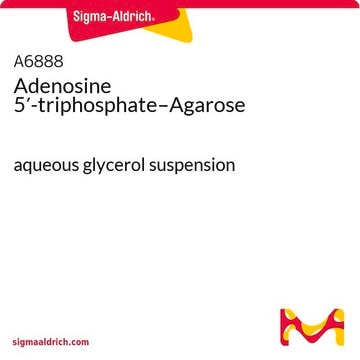This product is a conjugate of 5'-ATP to crosslinked 4% beaded agarose (activated by cyanogen bromide), via the C-8 atom of 5'-ATP. A 9-atom matrix spacer arm connects the ATP and the agarose. Please see the link below to review the product datasheet for more information:
https://www.sigmaaldrich.com/deepweb/assets/sigmaaldrich/product/documents/174/887/a2767pis.pdf
A2767
Adenosine 5′-triphosphate–Agarose
lyophilized powder
Synonyme(s) :
5′-ATP agarose
Sélectionner une taille de conditionnement
151.00 CHF
Sélectionner une taille de conditionnement
About This Item
151.00 CHF
Produits recommandés
Source biologique
plant (Sea weed)
Forme
lyophilized powder
Ampleur du marquage
1-5 μmol per mL
Matrice
cross-linked 4% beaded agarose
Activation de la matrice
cyanogen bromide
Fixation de matrice
C-8
Espaceur de matrice
9 atoms
Température de stockage
−20°C
Chaîne SMILES
[X]Nc1ncnc2[n](cnc21)[C@@H]3O[C@@H]([C@H]([C@H]3O)O)CO[P](=O)(O[P](=O)(O[P](=O)(O)O)O)O
Vous recherchez des produits similaires ? Visite Guide de comparaison des produits
Catégories apparentées
Description générale
Application
Forme physique
Code de la classe de stockage
11 - Combustible Solids
Classe de danger pour l'eau (WGK)
WGK 3
Point d'éclair (°F)
Not applicable
Point d'éclair (°C)
Not applicable
Équipement de protection individuelle
Eyeshields, Gloves, type N95 (US)
Faites votre choix parmi les versions les plus récentes :
Certificats d'analyse (COA)
Vous ne trouvez pas la bonne version ?
Si vous avez besoin d'une version particulière, vous pouvez rechercher un certificat spécifique par le numéro de lot.
Déjà en possession de ce produit ?
Retrouvez la documentation relative aux produits que vous avez récemment achetés dans la Bibliothèque de documents.
Les clients ont également consulté
-
Where is the linker attached on the ATP molecule
1 answer-
Helpful?
-
-
How can I hydrate Product A2767, Adenosine 5´-triphosphate-Agarose?
1 answer-
The resin can be hydrated by placing it in excess water, approximately 50 mL per g of resin, for at least 30 minutes. Remove the lactose stabilizer by washing the resin on a Buchner funnel with gentle vacuum, using approximately 100 mL of water per g of resin. Do not allow the resin to dry. Resuspend the resin in excess water or starting buffer to pack the column bed.
Helpful?
-
-
How can I regenerate Product A2767, Adenosine 5´-triphosphate-Agarose?
1 answer-
Since N6-[N-(6-aminohexyl)-carbamyl]-ADP is a substrate for acetate kinase and pyruvate kinase, these enzymes can be used to regenerate ATP from ADP on the resin under conditions favoring the reverse reaction. Wash the resin with 20 volumes of 50 mM Tris HCl buffer (pH 8.2), with 0.2 mM EDTA and 100 mM KCl. Incubate the resin overnight at 2-8°C in an ATP-regenerating mixture containing 0.2 mM phosphoenol pyruvate, pyruvate kinase (10 units per mL of resin), 5 mM MgCl2, 0.2 mM EDTA and 100 mM KCl in 50 mM Tris HCl buffer (pH 8.2). Wash the resin with 25 column volumes of 2 mM ATP in 2 M KCl and reequilibrate the resin with 25 column volumes of sample buffer. Alternatively, the ATP regenerating mixture can contain 20 mM acetyl phosphate, acetate kinase (6.8 units per mL of resin), and 3 mM MgCl2 in 100 mM Tris HCl (pH 7.6). If acetate kinase is used, prewash the resin with 25 column volumes of 100 mM Tris HCl (pH 7.6), but use the same final wash and reequilibration steps as given for pyruvate kinase.
Helpful?
-
-
What is the Department of Transportation shipping information for this product?
1 answer-
Transportation information can be found in Section 14 of the product's (M)SDS.To access the shipping information for this material, use the link on the product detail page for the product.
Helpful?
-
-
How can I elute my proteins from Product A2767, Adenosine 5´-triphosphate-Agarose?
1 answer-
Specifically bound proteins can be eluted with 10-100 mM ATP or ADP. Nonspecifically bound proteins can be eluted with 2 M NaCl or KCl in water or 7 M urea.
Helpful?
-
-
Can I store Product A2767, Adenosine 5´-triphosphate-Agarose, after I have hydrated it?
1 answer-
For the short term, it is possible to store the hydrated resin in 20% ethanol and dilute buffer at 2-8°C. In general, the hydrated resin can be stored refrigerated in water or buffer containing a bacteriostat, such as 0.02% sodium azide or thimerosal. Do not autoclave or freeze the hydrated resin. The resin can be used several times without loss of effectiveness. However, the ATP will slowly hydrolyze to ADP over time, and under certain conditions this process may be accelerated during usage. The resin can be regenerated; please see the regeneration FAQ for this product.
Helpful?
-
Active Filters
Notre équipe de scientifiques dispose d'une expérience dans tous les secteurs de la recherche, notamment en sciences de la vie, science des matériaux, synthèse chimique, chromatographie, analyse et dans de nombreux autres domaines..
Contacter notre Service technique





